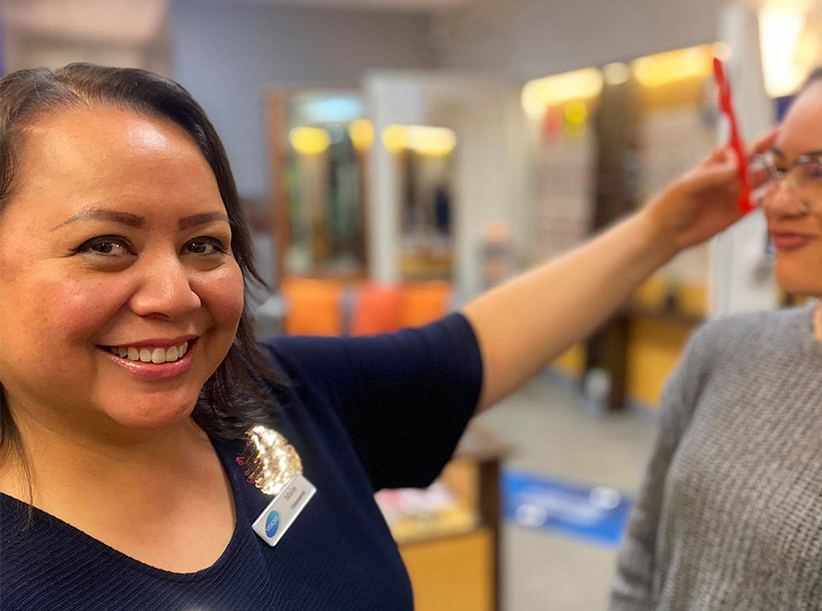Finding the Perfect Pair - A Guide to Prescription Glasses

When it comes to buying prescription glasses, sunglasses, or prescription safety glasses, making the right choice is essential. From the frame and fit, to the right lenses, the perfect pair can set you on your way to a life of confidence and convenience, making those day-to-day tasks that little bit easier.
But you may be wondering ‘how do I choose the right glasses?’ With so many frames to choose from, different lens requirements and applications, plus your own personal style to consider, buying prescription glasses or sunglasses without the right guidance can quickly turn into a hassle.
If you’ve found yourself in this situation, don’t worry. Eye Spy is here to help. Whether you need your eyes examined, prescription advice, or even some suggestions on personal styles that may be suited to you, our team can set you in the right direction and have you on your way to seeing clearly.
Here are some of our top tips for buying your next pair of prescription glasses or sunglasses:
1. Renew your prescription
First things first: it’s time to renew your prescription.
An up-to-date eye exam will put you in the best place to determine which prescription lenses are optimal, and will help you get the most from your new glasses.
What’s more, an eye examination will screen for other eye conditions, from macular degeneration and myopia, to dry eye, glaucoma and more, and give you peace of mind about the general health and quality of your vision.
With this knowledge, and an up-to-date prescription in hand, you’ll have a good understanding of the lenses best suited to you, which is the first piece of the puzzle.
If it’s been a while since your last check-up, schedule an eye examination today.
Choosing the best lenses for you
Your prescription will inform the type of lenses best suited to you, which can include:
Single vision lenses
Single vision lenses are most common and are used to correct near & far sightedness, or for help when reading.
Bifocal lenses
Bifocal lenses have two vision corrections, on the lower part to assist with reading or seeing things closely, and the upper for seeing at a distance.
Progressive lenses
Progressive lenses have three prescriptions in one pair of glasses. That allows you to see well in the distance (like vision for driving), middle-distance work (like checking out a website on a computer), and close-up work (like reading your phone or a book). It has the added advantage of having no visible lines in the lens..
2. Find your frames
With your prescription taken care of, now the fun begins. Glasses can be much more than just a visual aid. They’re an extension of you, a fashion statement, and something you wear daily that you should be proud of, and most importantly, feel comfortable in.
Everyone is different, and your face shape can determine which frames might look best on you. Consider the shapes below, see where you fit in, then ask our team to guide you to the right pair.
Oval
An oval face shape means higher, wider cheekbones that narrow towards the forehead. This shape is suited to a wide range of styles, including square and rectangular shapes.
Square
Square face shapes are widest along the forehead and jaw. Here, you want to add length, so frames that sit higher on the nose are a great option. You can also consider how to compliment this feature with your frame style, with rounded frames softening the angles of your face and creating a flattering contrast.
Round
For round face shapes, angular frames are perfect. They add depth, definition and again, add an illusion of length to your face that can be flattering!
Heart
Heart shaped faces are widest at the forehead, suiting round or oval sunglass shapes. Here, you want to bring attention to the top of your face, considering frames that may be slightly wider than your forehead area. Rimless styles can be a great option and work to soften features even more.
Triangle
Triangle face shapes are narrower in the forehead area, but with wider jawlines. Wider frames will help to balance this look, by making your forehead appear wider. You may also want to try frames with added detail and colour to bring the attention to the upper area of your face.
Diamond
Like actual diamonds, diamond face shapes are the least common. Here, your cheeks will be wider, with a narrower jawline and forehead. Oval frames work best for this shape, softening angular features to create a balanced look.
3. Get measured
A prescription is a great start, but many of us have had that feeling of glasses that just didn’t sit perfectly with us.
There are a number of measures that can be taken prior to your next glasses purchase, like pupillary distance, which ensures the centre of your new lenses sits directly in front of your pupil. These small adjustments can make a world of difference, and ensure your glasses fit seamlessly.
Book an appointment with our team to discuss a frame fitting today.
4. All day coverage
Standard glasses will have you covered most of the day, but when you head outside it’s a different story.
With summer fast approaching, ensuring you have prescription sunglasses, or prescription safety eyewear when you transition outside will ensure your vision is optimised all day long. This will also protect your eyes against the elements and limit things like UV and debris exposure.
Most of the sunglass options at Eye Spy can have prescription lenses fitted, whether you need polarised lenses, tinted or Transition lenses, we can work to your prescription fitting the lenses into your preferred sunglasses frame.
5. Special coatings
Just like our eyes, our daily routines can differ too. Some may spend a lot of time outside. For others, they may work in artificially-lit offices, or in front of computer screens at late hours in the evening. Others may be sensitive to light, or require eye drops for dry eyes.
Understanding your unique circumstances can inform whether you add any special coatings to your lenses, and can assist with reducing glare, reflections, eye protection, or blocking out harmful blue light that could contribute to things like a disrupted sleep cycle.
Speak with your optometrist about the situations your glasses are intended for, your daily habits and activities, and they can help you determine whether any of these additions are required.
If finding the perfect pair of prescription glasses still feels a little hazy, pop into Eye Spy. Our friendly team can help you with anything you need; from your initial eye examination and prescription to glasses fitting, frame selection and more. We can’t wait to help you find your perfect pair.
